Why History? Educating the Early Childhood Workforce for Equity

You are here
Editors' NoteThis article includes a number of online-only features, which are linked below:
There is growing awareness of the limitations of child development theories and research based primarily on a normative perspective of White, middle-class children. . . .
[It] requires understanding this broader societal context, the ways that historical and current inequities have shaped the profession, as they have shaped our nation.
—NAEYC, “Advancing Equity in Early Childhood Education”
Early childhood professionals usually spend little time thinking about the history of identity groups and its role in understanding family dynamics and children’s development. Our focus is usually on an individual’s direct experience, the here and now. Yet all of us belong to communities whose past experiences play a critical role in how we as individuals think and act. When we fail to consider history, we lose a valuable source of information about why people behave the way they do. This article focuses on people of African descent and speaks to how and why knowing their history can shed light on their current practices and help us design more responsive programs. Many aspects of this article may also speak to other marginalized groups because understanding the historical context of racism and the Black response is relevant to all communities of color in the United States.
Those of us in the human services recognize how a family’s history gives us insight into the present. We see a connection between past stresses and resources and the way people live their lives today. For example, divorce often causes interpersonal tensions that result in ruptured relationships between parents and children. The effects of this change may persist long after the divorce is finalized. However, when we know about the divorce, we can plan interventions specific to the family, such as attention to separation and abandonment issues.
The same process applies to communities. The past continues to influence its members. Cultures, like people, are not static, but the effect of prior experiences lingers as new experiences are viewed through the lens of the community’s history.
Some teachers know that Black children and families are different but believe such differences are superficial. For example, they may think whether you eat cornbread or bagels for breakfast or broccoli or collards for supper are meaningless variations easily changed. While many food differences do reflect unimportant personal choices, others are important symbols. They relate to a person’s identity and help define who they are. For many Black Americans, cornbread and collards are not just nutrition, they are meaningful aspects of their community and its traditions. Changing recipes is not a minor adjustment, but one that requires changes in taste and enjoyment, which some Black families may resist.
Unfortunately, some teachers think differences in Black children and families are indications of incompetence or deficits. They do not connect the history—the past experiences—of the Black American community to how Black children and families think, feel, and act today. Because a teacher’s own culture is so intuitive and natural, they may feel theirs is the only right way to think and behave and anything different is abnormal; they expect everyone to share their truths. This assumption causes them to misunderstand the normalcy of Black children and families.
Differences are not caused by the Black Americans’ perversity or stupidity; they are caused by the differences in their experiences, past and present, from those of White Americans. Slavery, Jim Crow (legal segregation), and continuing oppression have had a pervasive influence on Black culture and, therefore, on community and family interactions. For example, some teachers see the discipline of Black American parents as harsh and authoritarian. However, when you understand the long history of White harassment and violence (even against children), the effects of segregation and community disinvestment, and the continuing unjust justice system, it is easy to understand the urgency of their discipline. There is no space for Black children to make a mistake, and Black parents recognize the danger; they believe that early and sharp discipline will help keep their children safe. Therefore, efforts to change the style of discipline in Black families without focusing on the causes are unlikely to be successful.
Teachers also are concerned about the disparities in achievement of children of color who lag behind their White peers. They ask, “Why don’t these children learn in school?” Most often, they only look for personal reasons for school failure—genes, family relationships, poor teachers, or curriculum. They don’t ask, “What are the structural inequities that affect the quality of Black children’s school experience?” When we ask this question, one of the things we find is inequity in the school funding formulas in many states (EdBuild 2019). These formulas do not resource programs as adequately for students from families with low income (who need it most) as they do for students from families with higher income (who need it less). Children of color are often the poorest, and therefore, suffer the most from regressive fiscal policies (Baker, Di Carlo, & Weber 2019). This is one example of systemic racism that leads to underfunded schools. Similar policy decisions result in white supremacist curricula, Euro-American centric pedagogy, color-blind practices, and disproportional rates of disciplinary action (Howard 2010; Gilliam et al. 2016; Derman-Sparks & Edwards with Goins 2020). These historical racist policies and practices make underachievement for children of color the most likely outcome.
When we fail to consider history, we lose a valuable source of information about why people behave the way they do.
Many cultural patterns cannot be fully understood without knowing their evolution. This article gives two examples that are rooted in slavery and affect ideas and practices today. These examples also illustrate how groups adapt as their experiences change. Finally, I suggest five things that early childhood professionals can do to promote equity using their understanding of community experience, actions that make us part of the solution rather than the problem.
Example 1: African American English Vernacular, Black English, or Ebonics
Many people consider African American English Vernacular (AAEV) to be an incorrect form of Standard English that indicates the ignorance of the speakers. In fact, Black people developed this language in what is now the United States during slavery because they came from different tribes with different languages and had to create a lingua franca to communicate with each other and their slave owners. They designed a language that contained elements of many of their home languages and English but combined them in a logical and linguistically consistent way. Instead of being a misuse of English, AAEV was (and is) an intellectual equivalent language to English (Labov 1970). During its development, AAEV reflected the separation of Black slaves from White owners; its continued use reflects segregation today—in housing, employment, education, religion, and many of the social amenities.
Jim Crow was codified in Plessy v. Ferguson in 1896 and remained in force until the Civil Rights Act of 1964 was enacted. During the great migration (1916–1970), Black Americans moved out of the South to northern cities where employment opportunities were greater. One might have expected them to begin speaking Standard English as they gained a foothold in the North; however even there, where segregation was not legally required, it was widespread and pervasive. Black people were almost as rigidly segregated in employment, residence, and schools in Los Angeles, Detroit, and Cleveland as they had been in the South. The community language persevered; Black Americans took the basic structure of AAEV with them. In northern ghettos, you could hear the community’s unique use of the verb to be: “I’s here” and “She be’s here.” As Black people continued to live segregated lives, they continued to use their language for social interaction (NPR 2017).
Unlike other ethnic groups, many economically advantaged Black Americans live in segregated Black neighborhoods, where the residents are poorer, less well educated, attend schools of lower quality, and use features of AAEV in their speech. What is it about their experiences that accounts for why they live in such communities? Two factors are important. One, Black Americans are likely to feel safer and more valued in Black communities. Most Black Americans regularly receive direct and indirect racial insult at their jobs, in the street, in public facilities, and in the legal system. Generally, Black people have more difficult lives than White people with the same or similar background (Denby 2017). Their physical safety as well as their self-esteem are regularly compromised. Comradery and the support of the community, including via a shared language, become important antidotes for both the depression and rage that this treatment elicits.
Two, racial segregation is determined by White people. It is responsive to the decisions made by banks, real estate agents, insurance companies, city governments, judges, and law enforcement (Nodjimbadem 2017). These decisions, though ostensibly made for economic reasons, are in reality often based on race and have a far-reaching effect on Black Americans. Legally and illegally, Black people are limited in their access to residences, employment, markets, insurance, and social opportunities outside of their own communities.
Today, Black speech is increasingly diverse as more opportunities open up outside of their communities and more Standard English is incorporated. Nevertheless, vestiges of AAEV have been retained in many communities, as red marks on student essays attest. Additional changes are inevitable as new experiences create new challenges (media, computers), but some forms will undoubtedly continue to be used as long as so many communities remain segregated. Interestingly, just as AAEV has changed in the last 50 years as interrace contact has increased, so too has Black slang spread outward to the general public, where it is now part of everyday speech for many Americans.
Example 2: Color and Colorism
We speak of people of color in the United States because of their common experiences with European and American prejudice and discrimination. The different meanings of skin color, however, are an illustration of how knowing history provides insight into different attitudes and different assimilation behavior among groups with African heritage.
Differences Within Groups
During slavery, children of mixed-race African slaves often lived in the homes of their White owners, thereby enjoying a more advantaged lifestyle. Skin color operated as a benefit, as the whiter the slave, the greater economic and social opportunity; however, Black people with White-like complexions and hair were still considered Black. The adage “One drop of African blood makes you Black” was originally designed to keep mixed-race people enslaved. Post-slavery, it has meant that no amount of White ancestry could overcome the stigma of African heritage.
With emancipation, the privilege of “house slaves” translated more easily into jobs and further education, so light-skinned Black people enjoyed privileges not always available to darker-skinned peers. Skin color conferred benefits in the White world and became a mark of beauty among Black Americans; “whiter skin” was deemed more attractive and often carried more benefits than darker coloring. After the civil rights era and the recognition that “Black is beautiful,” this preference became less important; however, skin color can still evoke ambivalent feelings within Black American communities.
Differences Between Groups
Color had a different history in Caribbean and Central and South American countries than in the United States. In these areas, just as in the United States, during and after slavery, mixed-race people enjoyed a more privileged lifestyle than their darker peers. However, unlike the United States, there was no legal Jim Crow, and the doctrine of “one drop” was not used as the criterion of who was Black. Unlike in the United States where race was fixed, people from these areas had different ideas about color, interracial mixing, and assimilation. Without anti-miscegenation laws, racial mixing did not have legal consequences, and many of these countries developed multiple racial divisions. The Caribbean nations, for example, were heavily dependent on Black slavery, but emancipation did not elicit legal Jim Crow as it did in the United States, and racial mixing was more prevalent.
The African experience was also different. Although Africans experienced the oppression of colonialism, they come from majority-Black countries, where Blackness is ubiquitous. In most of those countries, freedom from European direct domination is several generations old. In addition, as Ogbu and Simons (1998) point out, immigrants, like those of African and Caribbean descent, have come to the United States voluntarily and are more willing to adopt new customs. All Black groups are likely to face prejudice and discrimination in the United States, yet these seem to be less of a hindrance for Black immigrants. The Pew Foundation reports that on every measure of success—annual income, home ownership, education—African and Caribbean immigrants’ achievement exceeds that of native-born Black Americans (Valentine 2012; Anderson 2015). It suggests that voluntary Black immigrants, without the onus of colorism, are more able to cope with American barriers to achievement.
These examples show that history affects communities, but also that communities adapt to different experiences. They also show that if we want different outcomes for our democracy, we must change the experiences of communities as well as those of individuals.
We must be as active combatting the systemic forces of poverty and racism that imperil the community as we are in treating individuals for their effects.
Intervention: Early Childhood Programs
We are rightly quite pleased that early childhood programs can help alleviate some of the effects of inequitable education practices experienced by communities of color. However, it is essential for early childhood educators to recognize their limits as well. This was brought home to me during a visit to a Head Start center (an anti-poverty program), where the teacher and a grandparent proudly told me that the grandchild was the third generation in the program. A quick review of research on the intergenerational cycle of poverty shows that this was the expected outcome, not an unusual one.
Programs such as Head Start have shown positive educational and social results for poor children and their families (Deming 2009; Barr & Gibbs 2017); however, often those benefits do not persist or foster class mobility. The effects of early childhood programs may be curtailed by the quality of the preschool program or the inadequacy of the K–12 schools that the children subsequently attend. Or alternatively, change may be limited by the racism that members of the community encounter every day, which dooms children’s outlook and expectations for the future. This suggests that rather than focusing exclusively on the personal issues common to all families, anti-poverty programs for Black children must look at the broad range of factors that undermine communities, such as unsafe housing, job discrimination, bank and insurance policies, air and water expenditures, and tax allocations.
NAEYC’s “Advancing Equity in Early Childhood Education” position statement notes that focusing solely on an individual’s direct experiences should not prevent us from examining the sociocultural and historical influences on the Black American community and other marginalized groups. Instead, we must be as active combatting the systemic forces of poverty and racism that imperil the community as we are in treating individuals for their effects.
How Should the Early Childhood Profession Respond?
- The early childhood system has the obligation to deliver exemplary services in an equitable way. This means advocating for public policies that pay attention to quality and access for all. It also means making sure that current policies and practices consider cultural and linguistic differences as they plan for children and families.
- Early childhood professionals have an obligation to teach children about each other in a positive and respectful way. This is more than scheduling a food-tasting lunch or reading a book or two about Indigenous peoples. It requires thoughtful attention to communities, families, and materials so that what children learn is authentic and accurate.
- The early childhood professional should also be prepared to study the cultural patterns and history of the various groups in their programs to learn about their past and current experience. This is particularly important when groups have experienced generations of oppression, with inequalities in resources and justice. Most important, educators must understand the difference between knowing about the cultures of others and stereotyping them.
- While we focus on helping families deal with the stresses in their lives, we also need to work to change the systems that keep children of color from enjoying the benefits of full citizenship. Early childhood professionals, well versed in child development, have an obligation to advocate for policies and practices that support young children and their families. But educators need to be aware of how current systems continue to undermine competence and agency in Black communities. There are many sources—parents, books, the internet, classes, and knowledgeable community members—that can provide this information.
- Clearly, history cannot be changed, but cultures are not set in stone. New challenges and opportunities demand changes in beliefs and practices. This means that our responsibility to sponsor equity does not end with quality and access or knowledge of history. It includes the responsibility to take an active role in advocating corrective policy. This means bringing all voices to the table to share public policy debates. It means advocating for equity both as a member of professional organizations and a citizen in our society.
Essential Readings by Barbara T. Bowman
Barbara Taylor Bowman is one of the seminal leaders in early childhood education. She is a founder and past president of the Erikson Institute in Chicago, IL, as well as a former consulting editor and president of NAEYC. She has advanced the field through research, policy, and practice. Following are just some of the works she has written, edited, or contributed to during her esteemed career.
NAEYC Publications
- Advancing Equity and Embracing Diversity in Early Childhood Education: Elevating Voices and Actions (2021). Contributor
Advancing equity in early childhood education requires understanding the broader societal contexts, biases, and ways in which historical and current inequities have shaped education systems in the United States. This book expounds on NAEYC’s position statement on advancing equity by addressing the social injustices that are systemic in every aspect of education and by showing how teachers, administrators, researchers, faculty, and the broader community can enact equity practices in their daily lives.
- Advancing Equity: Early Childhood Educators Expand on the NAEYC Position Statement (2021). Contributor
NAEYC’s Advancing Equity Position Statement challenges us to think critically about the caring for and educating of the young children in this country.
- Spotlight on Young Children: Equity and Diversity (2019). Contributor
Part of NAEYC’s Spotlight series, this book shares research, reflections, and practical ideas from educators across the country as they explore what developmentally, culturally, and linguistically responsive education looks like.
- Leadership in Early Care and Education (1997). Editor
This book addresses the essential components of leadership and aims to create frameworks for leadership in early childhood education.
- Young Children, “Addressing the African-American Achievement Gap: Three Leading Educators Issue a Call to Action” (May 2018)
When matched for social class, the gap in educational achievement between African Americans and other groups is substantial and affects the well-being of the entire country. This article outlines some of the factors that contribute to the achievement gap between African Americans and White Americans and ends with recommendations for educators, administrators, and policy makers to help equalize educational opportunities.
Other Publications
- Eager to Learn: Educating Our Preschoolers (2001). Co-editor
This book, published by the National Academics Press in Washington, DC, examines education and care for children between 2 and 5. It documents how early in life learning begins and presents a comprehensive framework for improving education for our youngest learners.
- Foreward. Literacy Leadership in Early Childhood: The Essential Guide. New York: Teachers College Press, 2007.
- Co-editor. School Readiness and Social-Emotional Development: Perspectives on Cultural Diversity. Silver Spring, Maryland: National Black Child Development Institute, 2006.
- Editor. Love to Read: Essays in Developing and Enhancing Early Literacy Skills of African American Children. Silver Spring, Maryland: National Black Child Development Institute, 2002.
- Author. Math, Science, and Technology in Early Childhood Education. Chicago, IL: Erikson Institute for Advanced Study in Child Development, 1998.
- Author. Cultural Diversity and Academic Achievement: Urban Education Program. US Dept. of Education, Office of Educational Research and Improvement, Educational Resources Information Center, 1994.
- Author. 1989. “Educating Language-Minority Children: Challenges and Opportunities,” The Phi Delta Kappan 71 (2): 118–120.
Children’s Books that Address Race and Equity
Advancing equity in the classroom means teachers must ensure that all children see themselves and their daily experiences positively reflected in curricula, learning environments, interactions, and materials. The following books offer just a few ways to celebrate diversity and provide perspectives that recognize beauty and value across differences.
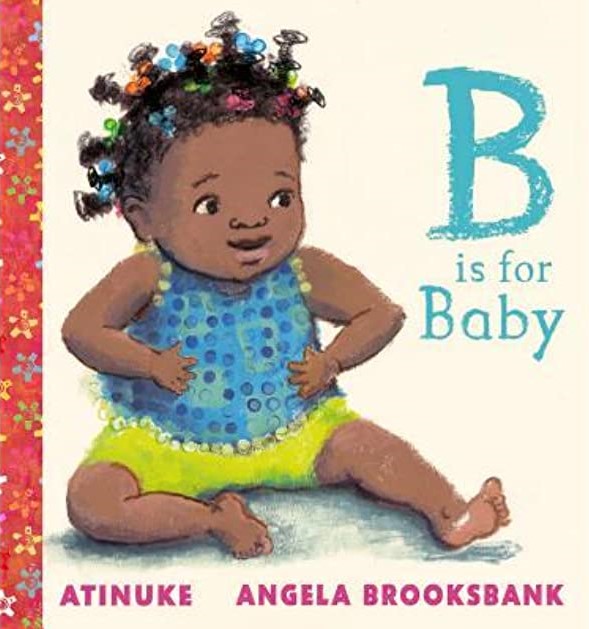 B Is for Baby, by Atinuke. Illus. by Angela Brooksbank. 2019. Candlewick Press.
B Is for Baby, by Atinuke. Illus. by Angela Brooksbank. 2019. Candlewick Press.
When a big brother sets out on his bike to see his Baba, carrying a basket of bananas on the back, he doesn’t realize that his baby sister is hiding in the basket and coming along for the ride. Set in West Africa, this is a sweet story about a day in the life of one family, told with words that start with the letter B.
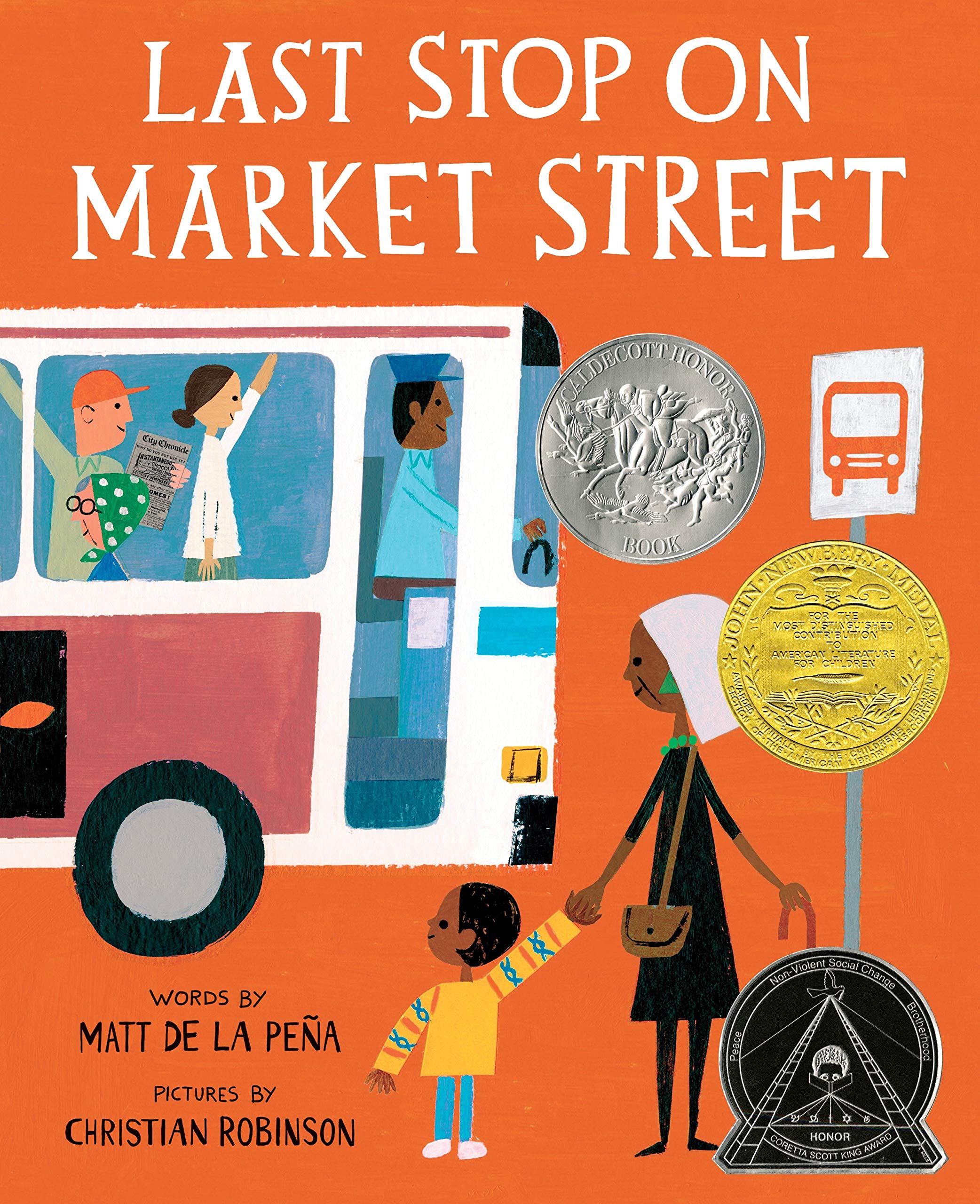 Last Stop on Market Street, by Matt de la Peña. Illus. by Christian Robinson. 2015. G.P. Putnam’s Sons Books for Young Readers.
Last Stop on Market Street, by Matt de la Peña. Illus. by Christian Robinson. 2015. G.P. Putnam’s Sons Books for Young Readers.
When CJ and his Nana ride the bus home, CJ wonders why the street where they get off does not seem as beautiful as some of the others. This book highlights finding beauty in difficult life circumstances. It invites readers to ask questions about economic inequality.
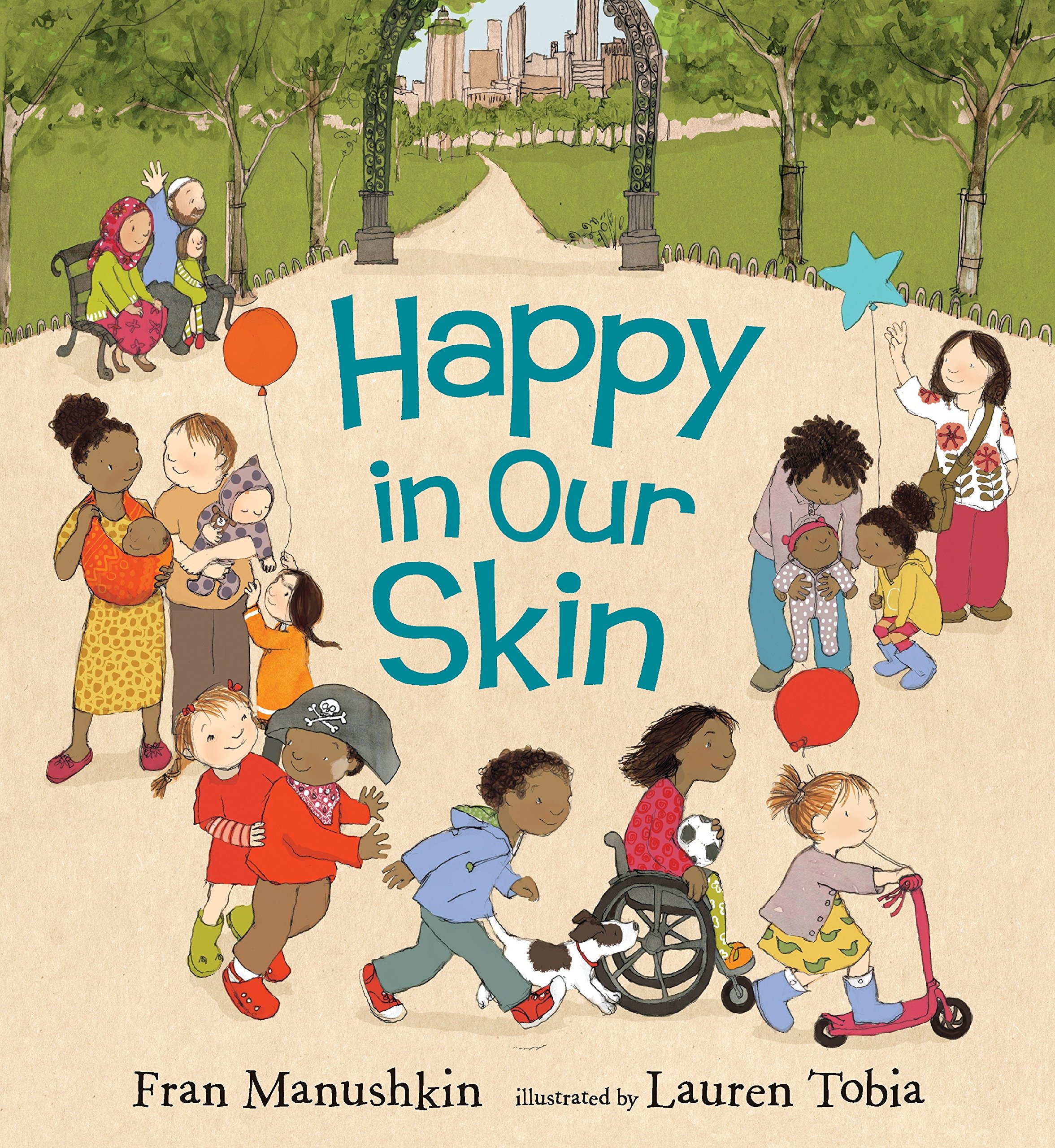 Happy in Our Skin, by Fran Manushkin. Illus. by Lauren Tobia. 2015. Candlewick Press.
Happy in Our Skin, by Fran Manushkin. Illus. by Lauren Tobia. 2015. Candlewick Press.
This celebration of skin of every color gives children ideas for how to use positive, descriptive language to describe their own skin color.
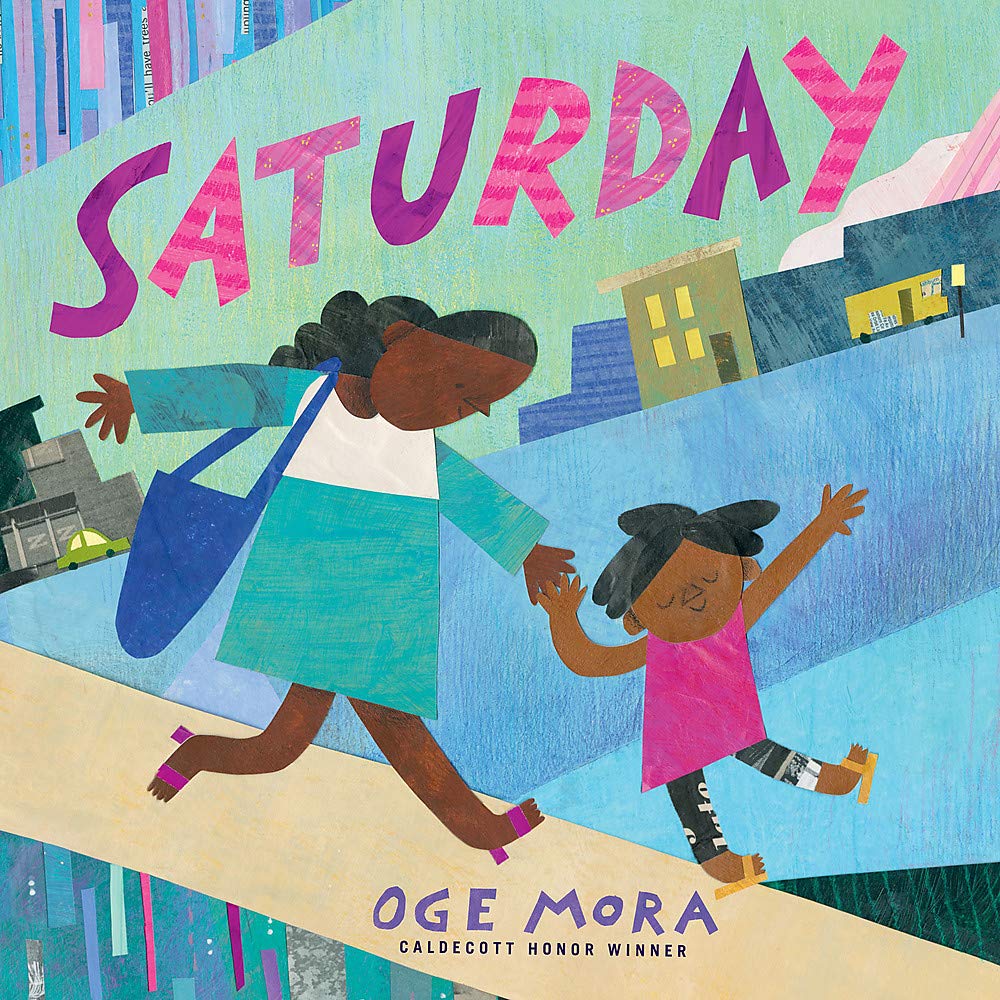 Saturday, by Oge Mora. 2019. Little, Brown and Company.
Saturday, by Oge Mora. 2019. Little, Brown and Company.
Saturday is a special day for Ava and her mother, who works six days a week. But when things go wrong one Saturday, frustrations run high—until the two remember that Saturdays are special because they spend them together.
B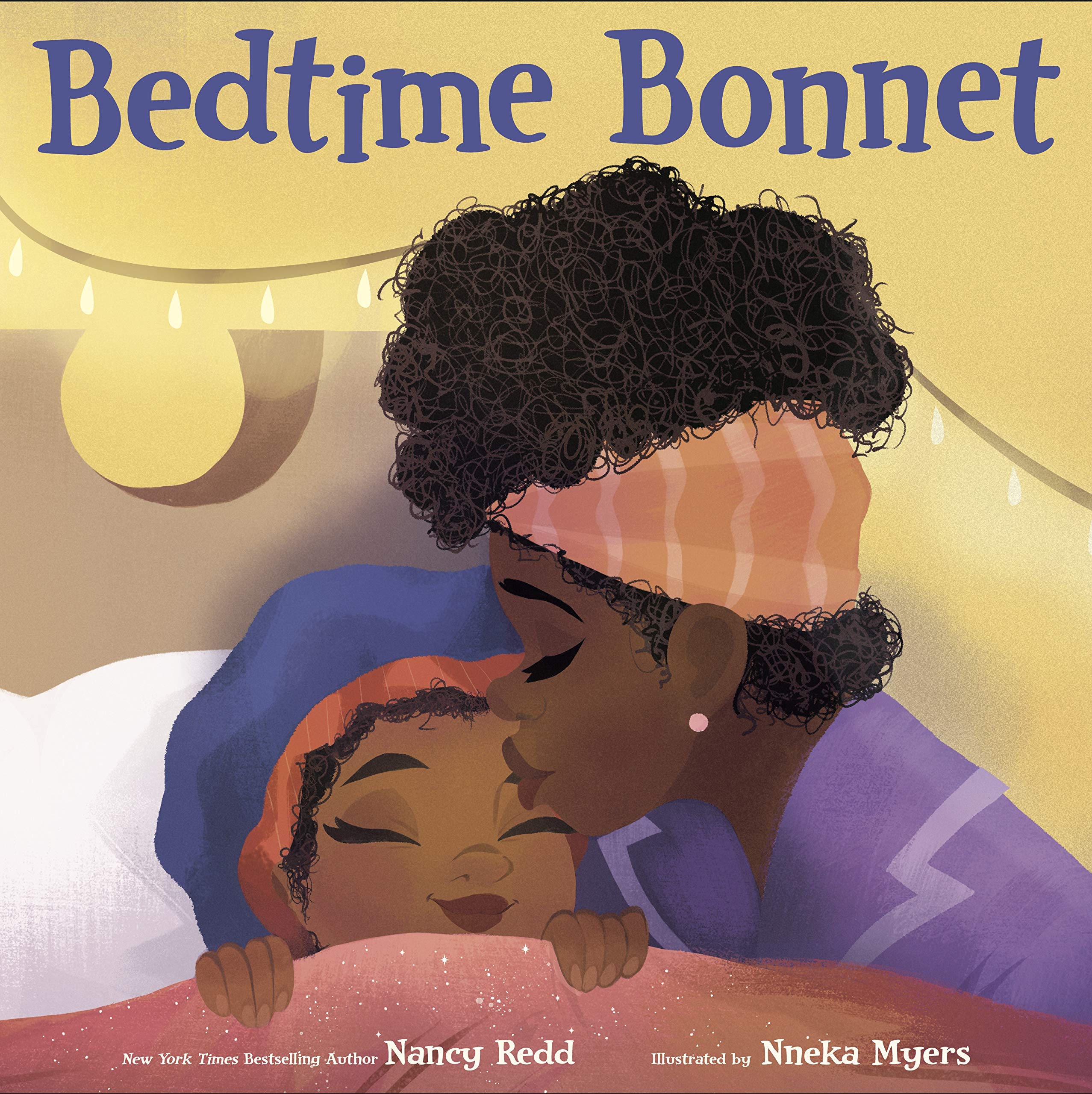 edtime Bonnet, by Nancy Redd. Illus. by Nneka Myers. 2020. Random House Children’s Books.
edtime Bonnet, by Nancy Redd. Illus. by Nneka Myers. 2020. Random House Children’s Books.
In this joyful ode to family and the importance of hair in Black culture, evening is the time for family members to put their hair up for the night. The little daughter needs her bedtime bonnet to protect her hair from tangles and lint, but it’s nowhere to be found! The whole family participates in the search, which has an unexpected ending.
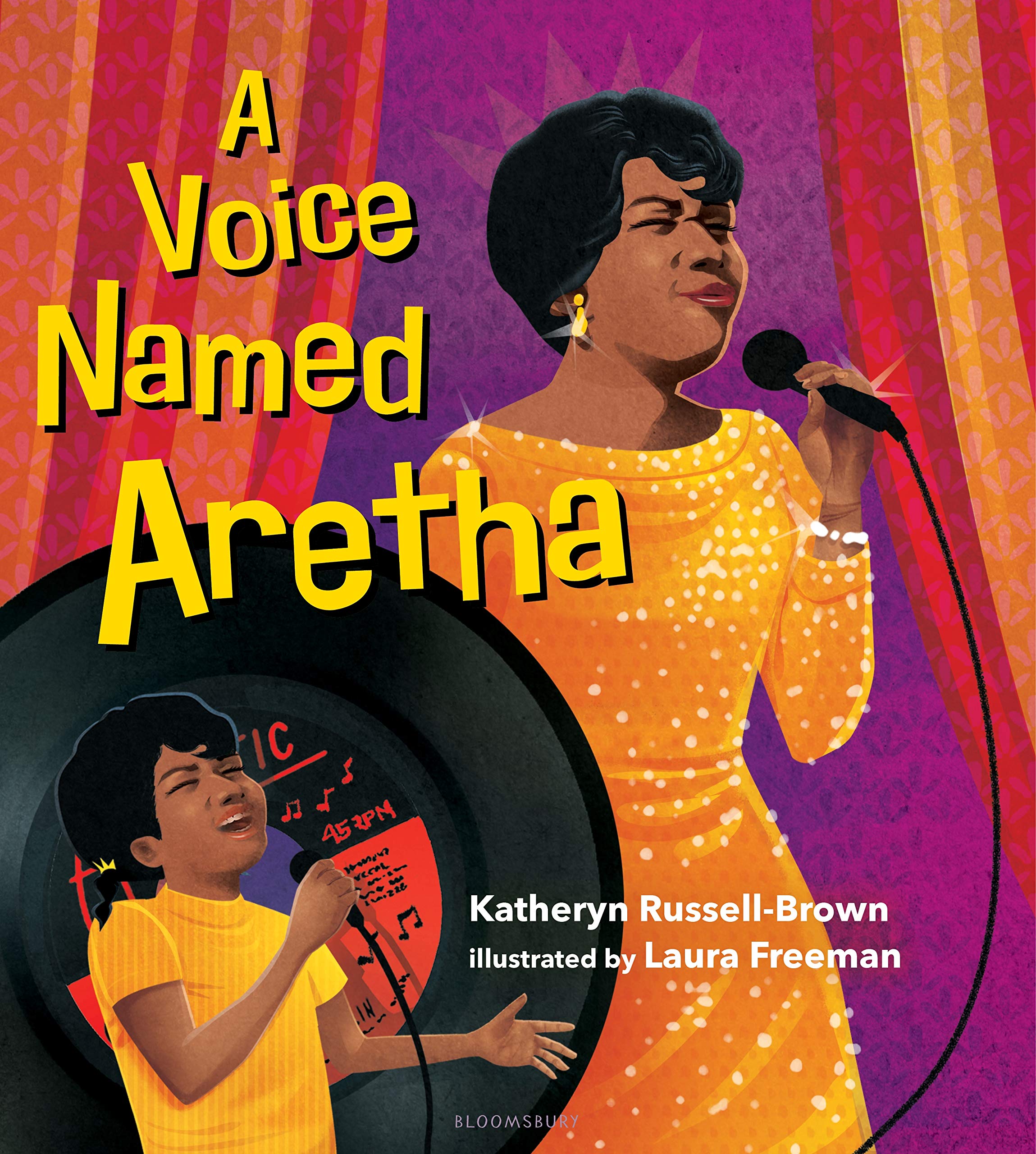 A Voice Named Aretha, Katheryn Russell-Brown. Illus. by Laura Freeman. 2020. Bloomsbury Children’s Books
A Voice Named Aretha, Katheryn Russell-Brown. Illus. by Laura Freeman. 2020. Bloomsbury Children’s Books
From an early age, the Queen of Soul lived a fascinating life at the intersection of the Black church, the Civil Rights movement, and American music culture. In this telling, Russell-Brown’s compelling writing is chock-full of interesting and moving details, and Freeman’s illustrations capture the weight of the challenges Franklin faced as well as the uplifting power of her music.
For more book ideas, visit “What About the Children? Teachers Cultivating and Nurturing the Voice and Agency of Young Children” by Brian L. Wright.
Tips for Selecting Diverse Children’s Literature
- Base your selection on quality. Books should not just teach a lesson but should have a good story, high-quality text, and engaging illustrations.
- Choose books that help children see themselves. Include books that mirror different aspects of identity (race, setting, beliefs) of children in the class, so that they can imagine themselves in the story.
- Choose books that help children expand their understanding of others in this multicultural world. Include books that introduce children to new people, places, and concepts that they may not have encountered yet.
- Look widely for texts. Be alert to new titles related to diversity. Tap the library for out-of-print titles that appeal to children and relate to urban issues and diversity.
- Use text sets. These book collections may be organized by theme or may feature the work of a highly accomplished author or illustrator of color. Great picks for books by Black writers and artists include those by Christopher Myers, Floyd Cooper, Jacqueline Woodson, Ashley Bryan, Jerry Pinkney, Brian Pinkney, and E.B. Lewis.
For more ideas and information on building diverse and equitable classroom libraries, visit https://www.naeyc.org/resources/pubs/yc/may2016/culturally-responsive-classroom.
Photographs: © Getty Images
Copyright © 2021 by the National Association for the Education of Young Children. See Permissions and Reprints online at NAEYC.org/resources/permissions.
This article supports recommendations from NAEYC's advancing equity position statement
Recommendations for Everyone
Item 6: Recognize that the professional knowledge base is changing.
Recommendations for Early Childhood Educators
Advocate on Behalf of Young Children, Families, and the Early Childhood Profession
Item 1: Speak out against unfair policies or practices and challenge biased perspectives.
Item 2: Look for ways to work collectively with others who are committed to equity.
References
Anderson, M. 2015. A Rising Share of the U.S. Black Population Is Foreign Born; 9 Percent Are Immigrants; and While Most Are from the Caribbean, Africans Drive Recent Growth. Report. Washington, DC: Pew Research Center. www.pewsocialtrends.org/2015/04/09/a-rising-share-of-the-u-s-black-population-is-foreign-born.
Baker, B.D., M. Di Carlo, & M. Weber. 2019. The Adequacy and Fairness of State School Finance Systems. Report. Washington, DC: Albert Shanker Institute; New Brunswick, NJ: Rutgers Graduate School of Education. www.shankerinstitute.org/resource/adequacy-and-fairness-state-school-finance-systems.
Barr, A., & C.R. Gibbs. 2017. “Breaking the Cycle? Intergenerational Effects of an Anti-Poverty Program in Early Childhood.” EdPolicyWorks Working Papers Series No. 61. University of Virginia.
Deming, D. 2009. “Early Childhood Intervention and Life-Cycle Skill Development: Evidence from Head Start.” American Economic Journal: Applied Economics 1 (3): 111–134.
Denby, G. 2017. “How Black Americans See Discrimination.” NPR, October 25. www.npr.org/sections/codeswitch/2017/10/25/559015355/how-black-americans-see-discrimination.
Derman-Sparks, L., & J.O. Edwards. With C.M. Goins. 2020. Anti-Bias Education for Young Children and Ourselves. 2nd ed. Washington, DC: NAEYC.
EdBuild. 2019. 23 Billion. Report. Jersey City, NJ: EdBuild. www.edbuild.org/content/23-billion.
Gilliam, W.S., A.N. Maupin, C.R. Reyes, M. Accavitti, & F. Shic. 2016. “Do Early Educators’ Implicit Biases Regarding Sex and Race Relate to Behavior Expectations and Recommendations of Preschool Expulsions and Suspensions?” Research brief. New Haven, CT: Yale University Child Study Center.
Howard, T.C. 2010. Why Race and Culture Matter in Schools: Closing the Achievement Gap in America’s Classrooms. New York: Teachers College Press.
Labov, W. 1970. “The Logic of Non-Standard English” In Language and Poverty, ed. F. Williams. Chicago: Markham Press.
Nodjimbadem, K. 2017. “The Racial Segregation of American Cities Was Anything But Accidental.” Smithsonian Magazine, May 30. www.smithsonianmag.com/history/how-federal-government-intentionally-racially-segregated-american-cities.
Ogbu, J.U., & H.D. Simons. 1998. “Voluntary and Involuntary Minorities: A Cultural-Ecological Theory of School Performance with Some Implications for Education.” Anthropology Education Quarterly 29 (2): 155–188.
Valentine, C. 2012. “Rethinking the Achievement Gap: Lessons from the African Diaspora.” The Washington Post, September 4. www.washingtonpost.com/blogs/therootdc/post/rethinking-the-achievement-gap-lessons-from-the-african-diaspora/2012/09/04/eebc5214-f362-11e1-a612-3cfc842a6d89_blog.html?noredirect=on&utm_term=.9ccacd763ff1.
Barbara T. Bowman is the Irving B. Harris Professor at Erikson Institute. She was chief officer for early childhood education at the Chicago Public Schools (2004–2012) and a consultant to the US Department of Education (2009), and she served on the White House Initiative on Educational Excellence for African Americans (2014–2016). Bowman is a member of the Chicago Public Library Board of Directors and is also on the boards of a number of practice and policy organizations. [email protected]